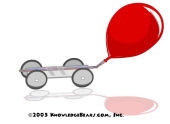
Purpose
To demonstrate Newton's Third Law of Motion by constructing a balloon-powered rocket car.
Additional information
Newton's Third Law of Motion (law of reciprocal actions) states: "Whenever a particle A exerts a force on another particle B, B simultaneously exerts a force on A with the same magnitude in the opposite direction. The strong form of the law further postulates that these two forces act along the same line." This law is often summed up in the very cliché saying "Every action has an equal and opposite reaction".
Sponsored Links
Required materials
- Large Styrofoam tray to construct the car body and wheels from (or any flat Styrofoam piece)
- 4 pins (to serve as wheel axels)
- Cellophane tape
- Flexi-straw
- Scissors
- Drawing compass
- Marker pen
- Small to medium party balloon
- Ruler
Estimated Experiment Time
Approximately an hour to construct the car and conduct the experiment
Step-By-Step Procedure
- 1. Using your ruler, drawing compass, and marker, draw a rectangle on the Styrofoam tray that's 7.5cm by 18cm. Draw an additional 4 circles at 7.5cm in diameter.
- 2. Use the scissors to cut the rectangle and 4 circles from the Styrofoam tray.
- 3. Stretch the balloon by inflating it several times and letting the air out.
- 4. Insert the balloon nozzle over the short end of the flexi-straw (nearest to the bendable section). Secure the balloon nozzle to the straw with tape. Make sure to seal it tight while ensuring the balloon can be inflated by blowing into the straw.
- 5.
 Tape the straw to the rectangle. To do this properly, place the straw so it's in the center of the width of the rectangle. Allow the section of the straw with the balloon attached to be raised slightly while the end without the balloon should extend about an inch or two over the rectangle (see illustration)
Tape the straw to the rectangle. To do this properly, place the straw so it's in the center of the width of the rectangle. Allow the section of the straw with the balloon attached to be raised slightly while the end without the balloon should extend about an inch or two over the rectangle (see illustration)
- 6. Push a pin into the center of the circles and then push into the Styrofoam rectangle to make four wheels. Make sure to leave some room for the wheels to spin (too tight and the wheels won't rotate).
- 7. Inflate the balloon through the straw. Pinch the straw nozzle, place the car on a flat smooth surface, and then release the straw. Weeeee!!!!!
Note
If you're having trouble getting the wheels to stay on, you may need either a thicker piece of Styrofoam or thicker pins. Make sure when inserting the wheels you leave some of the pin sticking out so the wheels don't slide off. Also, feel free to construct cars of varying shapes and sizes to see how their affected by the experiment. Originality and creativity in car construction is encouraged!
Observation
Make careful note of the movement of the car in relation to the balloon size. You should record your observations in a journal. Some questions that may be answered are: What happens when the balloon nozzle is released? Can you explain why and how the car is propelled across the floor? Can you explain how Newton's Third Law is being applied in this project?
Result
When the straw is released, the car is thrust forward and propelled across the floor. This project satisfies Newton's Third Law of Motion of "Every action has an equal and opposite reaction". In this case, the air escaping through the straw (the thrust) is the action while the car's propulsion across the room in the opposite direct is the reaction.
Sponsored Links
Take a moment to visit our table of Periodic Elements page where you can get an in-depth view of all the elements,
complete with the industry first side-by-side element comparisons!